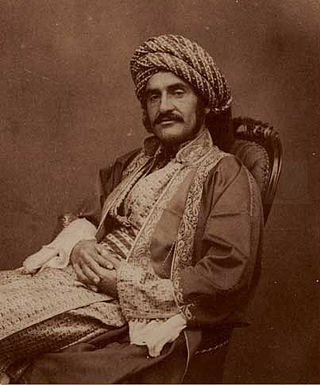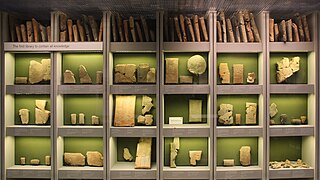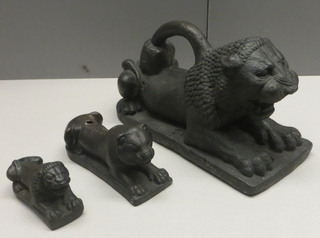
A lens is a transmissive optical device that focuses or disperses a light beam by means of refraction. A simple lens consists of a single piece of transparent material, while a compound lens consists of several simple lenses (elements), usually arranged along a common axis. Lenses are made from materials such as glass or plastic and are ground, polished, or molded to the required shape. A lens can focus light to form an image, unlike a prism, which refracts light without focusing. Devices that similarly focus or disperse waves and radiation other than visible light are also called "lenses", such as microwave lenses, electron lenses, acoustic lenses, or explosive lenses.

Nineveh, also known in early modern times as Kouyunjik, was an ancient Assyrian city of Upper Mesopotamia, located in the modern-day city of Mosul in northern Iraq. It is located on the eastern bank of the Tigris River and was the capital and largest city of the Neo-Assyrian Empire, as well as the largest city in the world for several decades. Today, it is a common name for the half of Mosul that lies on the eastern bank of the Tigris, and the country's Nineveh Governorate takes its name from it.

Timeline of microscope technology

Sir Austen Henry Layard was an English Assyriologist, traveller, cuneiformist, art historian, draughtsman, collector, politician and diplomat. He was born to a mostly English family in Paris and largely raised in Italy. He is best known as the excavator of Nimrud and of Nineveh, where he uncovered a large proportion of the Assyrian palace reliefs known, and in 1851 the library of Ashurbanipal. Most of his finds are now in the British Museum. He made a large amount of money from his best-selling accounts of his excavations.

Hormuzd Rassam was an Assyriologist and author. He is known for making a number of important archaeological discoveries from 1877 to 1882, including the clay tablets that contained the Epic of Gilgamesh, the world's oldest notable literature. He is widely believed to be the first-known Middle Eastern and Assyrian archaeologist from the Ottoman empire. He emigrated to the United Kingdom, where he was naturalized as a British citizen, settling in Brighton. He represented the government as a diplomat, helping to free British diplomats from captivity in Ethiopia.

A refracting telescope is a type of optical telescope that uses a lens as its objective to form an image. The refracting telescope design was originally used in spyglasses and astronomical telescopes but is also used for long-focus camera lenses. Although large refracting telescopes were very popular in the second half of the 19th century, for most research purposes, the refracting telescope has been superseded by the reflecting telescope, which allows larger apertures. A refractor's magnification is calculated by dividing the focal length of the objective lens by that of the eyepiece.

Nimrud is an ancient Assyrian city located in Iraq, 30 kilometres (20 mi) south of the city of Mosul, and 5 kilometres (3 mi) south of the village of Selamiyah, in the Nineveh Plains in Upper Mesopotamia. It was a major Assyrian city between approximately 1350 BC and 610 BC. The city is located in a strategic position 10 kilometres (6 mi) north of the point that the river Tigris meets its tributary the Great Zab. The city covered an area of 360 hectares. The ruins of the city were found within one kilometre (1,100 yd) of the modern-day Assyrian village of Noomanea in Nineveh Governorate, Iraq.

A magnifying glass is a convex lens that is used to produce a magnified image of an object. The lens is usually mounted in a frame with a handle. Beyond its primary function of magnification, this simple yet ingenious tool serves a variety of purposes. It can be employed to focus sunlight, harnessing the Sun's rays to create a concentrated hot spot at the lens's focus, which is often used for starting fires.

The Royal Library of Ashurbanipal, named after Ashurbanipal, the last great king of the Assyrian Empire, is a collection of more than 30,000 clay tablets and fragments containing texts of all kinds from the 7th century BCE, including texts in various languages. Among its holdings was the famous Epic of Gilgamesh.

Mead Art Museum houses the fine art collection of Amherst College in Amherst, Massachusetts. Opened in 1949, the building is named after architect William Rutherford Mead, of the prestigious architectural firm McKim, Mead & White. His wife, Olga Kilyeni Mead, left her entire estate to Amherst College. The museum, a member of Museums10, is free and open to the public.
Below are notable events in archaeology that occurred in 1845.

The Department of the Middle East, numbering some 330,000 works, forms a significant part of the collections of the British Museum, and the world's largest collection of Mesopotamian antiquities outside Iraq. The collections represent the civilisations of the ancient Near East and its adjacent areas.
Tarbiṣu was an ancient city about 3 miles north of Nineveh.

The Nimrud ivories are a large group of small carved ivory plaques and figures dating from the 9th to the 7th centuries BC that were excavated from the Assyrian city of Nimrud during the 19th and 20th centuries. The ivories mostly originated outside Mesopotamia and are thought to have been made in the Levant and Egypt, and have frequently been attributed to the Phoenicians due to a number of the ivories containing Phoenician inscriptions. They are foundational artefacts in the study of Phoenician art, together with the Phoenician metal bowls, which were discovered at the same time but identified as Phoenician a few years earlier. However, both the bowls and the ivories pose a significant challenge as no examples of either – or any other artefacts with equivalent features – have been found in Phoenicia or other major colonies.

The Statue of Ashurnasirpal II is a rare example of Assyrian sculpture in the round that was found in the mid nineteenth century at the ancient site of Kalhu by the famous archaeologist Austen Henry Layard. Dating from 883–859 BC, the statue has long been admired for its flawless condition and the high quality of its craftsmanship. It has been part of the British Museum's collection since 1851.

The Stela of Ashurnasirpal II is an enormous Assyrian monolith that was erected during the reign of Ashurnasirpal II. The stela was discovered in the mid nineteenth century at the ancient site of Kalhu by the famous British archaeologist Austen Henry Layard. Dated to between 883-859 BC, the sculpture is now part of the British Museum's collection.
Nimrud is an ancient city in modern Iraq.

The Assyrian lion weights are a group of bronze statues of lions, discovered in archaeological excavations in or adjacent to ancient Assyria.

Assyrian sculpture is the sculpture of the ancient Assyrian states, especially the Neo-Assyrian Empire of 911 to 612 BC, which was centered around the city of Assur in Mesopotamia which at its height, ruled over all of Mesopotamia, the Levant and Egypt, as well as portions of Anatolia, Arabia and modern-day Iran and Armenia. It forms a phase of the art of Mesopotamia, differing in particular because of its much greater use of stone and gypsum alabaster for large sculpture.

Phoenician metal bowls are approximately 90 decorative bowls made in the 7th–8th centuries BCE from bronze, silver and gold, found since the mid-19th century in the Eastern Mediterranean and Iraq. They were historically attributed to the Phoenicians, but are today considered to have been made by a broader group of Levantine peoples.

















